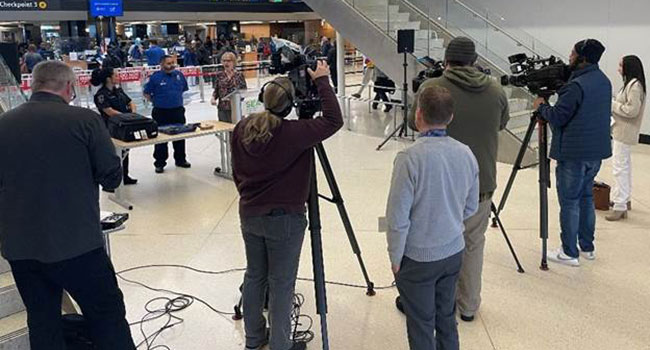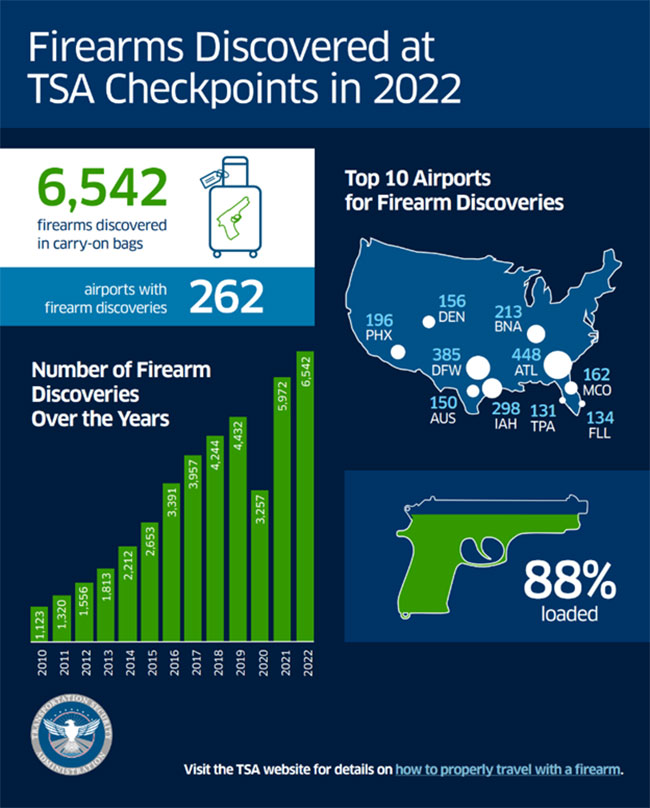Transportation Security Administration (TSA) officers in Washington detected 164 firearms in travelers’ carry-on luggage in 2022, with the majority of the firearms discovered at Seattle-Tacoma International Airport’s (SEA) security checkpoints. Routine X-ray screening of carry-on property yielded the firearms. Nationwide last year, TSA officers found 6,542 firearms at 262 different airports.

The five U.S. airports with the most TSA firearm discoveries are Hartsfield-Jackson Atlanta International Airport, which topped the list with 448 firearm finds. Dallas/Fort Worth International Airport came in second with 385 followed by Houston’s George Bush Intercontinental Airport with 298; Nashville International Airport with 213 and Phoenix Sky Harbor International Airport with 196. Orlando International Airport; Denver International Airport; Austin-Bergstrom International Airport; Fort Lauderdale-Hollywood International Airport and Tampa International Airport round out the Top 10.
In 2022, TSA screened approximately 761 million passengers and crew at airports nationwide. TSA officers across the country discovered firearms in carry-on luggage at a rate of 8.6 firearms per million passengers screened. Stated another way, TSA detected one firearm for every 116,394 travelers screened.

The busiest airport in Washington, located in Seattle, is where TSA officers screened approximately 17.2 million departing passengers and crew. Statistics show that travelers flying out of SEA brought firearms in carry-on luggage at a rate of around 6.56 firearms per million travelers screened, below the national average. That equates to a firearm discovered for every 156,610 travelers screened at SEA.
“These statistics should serve as a reminder to every gun owner that they need to be aware of the contents of their carry-on bag prior to coming to the security checkpoint. Firearms have never been allowed in the cabin of the aircraft and there is no acceptable excuse for bringing a gun in your carry-on,” said Gregory Hawko, TSA Federal Security Director for Washington. “Fortunately, we have a dedicated corps of TSA officers who remain vigilant while carrying out their security screening responsibilities. We are grateful for their role in securing the transportation system.
When a TSA officer sees the image of a firearm on the X-ray screen, TSA immediately notifies the local airport law enforcement agency, which responds to the security checkpoint. A law enforcement officer removes the firearm from the X-ray tunnel and makes contact with the traveler. What happens to the firearm and the traveler is up to the discretion of the airport law enforcement agency.
In addition to potential criminal citations for bringing a firearm in carry-on luggage, TSA can levy a civil penalty again the traveler. Among the factors TSA considers when determining the civil penalty amount include whether the firearm was loaded and whether there was accessible ammunition. Even if a traveler has a concealed weapons permit, firearms are not permitted in carry-on luggage.
Individuals who violate rules regarding traveling with firearms will have Trusted Traveler status and TSA PreCheck® expedited screening benefits revoked for a period of time. The duration of the disqualification will depend upon the seriousness of the offense and if there is a repeated history of violations.
Firearms can be transported on a commercial aircraft only if they are unloaded, packed in a locked, hard-sided case and placed in checked baggage. Any type of replica firearm is also prohibited in carry-on baggage and must be transported in checked luggage.
At the airport during the check-in process, a passenger needs to go to the airline ticket counter to declare the firearm, ammunition and any firearm parts. Prior to traveling, passengers are encouraged to check gun laws and regulations at their destination to ensure they comply with local and state laws. TSA also recommends travelers check with their airline prior to their flight to ensure they comply with any airline-specific requirements.
TSA has additional traveler information specifically related to the transportation of firearms and ammunition. A full summary of TSA’s civil penalties for prohibited items is also available.
TSA reminds passengers to be aware of the contents of their carry-on bag prior to coming to the security checkpoint. TSA has multiple resources available to passengers to help them determine whether an item is permitted in carry-on baggage, checked baggage or not at all.
Travelers can use the “Can I Bring” feature on the TSA website or on the TSA mobile app, myTSA. Travelers can also Tweet or Message “@AskTSA” if they have a travel question or are unsure if an item is allowed through security in a carry-on bag. Just snap a picture or send a question and get real-time assistance daily from 5 a.m. to 3 p.m. PST.